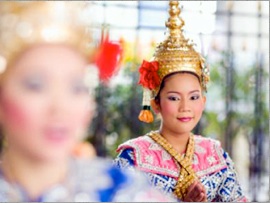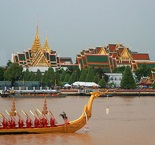

ABOUT THAILAND
Location: Thailand is situated in the heart of the Southeast Asian mainland, covering an area of 513,115 sq.km. and extends about 1,620 kilometres from north to south and 775 kilometres from east to west. Thailand borders the Lao People's Democratic Republic and the Union of Myanmar to the North, the Kingdom of Cambodia and the Gulf of Thailand to the East, the Union of Myanmar and the Indian Ocean to the West, and Malaysia to the south.
Capital: Bangkok
Major Cities: North : Chiangmai, South: Songkla, Central region : Ayutthaya and Chonburi, North Eastern : Nakhon Ratchasima and Khon Kaen
Historical Background:
There are conflicting opinions as to the origins of the Thais. Three decades ago it could be said with presumed certainty that the Thais originated in Northwestern Szechuan in China about 4,500 years ago and later migrated down to their present homeland. However, this theory has been altered by the discovery of remarkable prehistoric artifacts in the village of Ban Chiang in the Nong Han District of Udon Thani Province in the Northeast. These include evidence of bronze metallurgy going back 3,500 years, as well as other indications of a far more sophisticated culture than any previously suspected by archaeologists. It now appears that the a Thais might have originated here in Thailand and later scattered to various parts of Asia, including some parts of China. Siam is the name by which the country was known to the world until 1939 and again between 1945 and 1949. On May 11, 1949, an official proclamation changed the name of the country to "Prathet Thai", or "Thailand", by which it has since been known. The word "Thai" means "free", and therefore "Thailand" means "Land of the Free."
National Flag:
Thailand's national flag, ceremoniously raised each morning in every town and village, is composed of five horizontal bands of red, white, and blue. The harmony of design expresses the complimentary nature of these three pillars of the Thai nation.
This tri-colored flag, called in Thai the "trirong", first introduced by King Vajiravudh (Rama VI) in 1917, succeeded an earlier design that placed a white elephant (emblem of the absolute monarch) on a red background.

Climate: Thailand is a warm and rather humid tropical country with monsoonal climate. Temperatures are highest in March and April with average temperature of 28 degree Celsius to 38 degrees Celsius and humidity averaging between 82.8 percent to 73 percent
Seasons: Dry : March to May, Rainy: June to October, Cool: November to February.
Population: The population in Thailand is approximately 62 million, of which around 6 million live in the capital city, Bangkok.
Language: The national and official language is Thai while English is widely spoken and understood in major cities, particularly in Bangkok and in business circles.
Business Hours: Government and business offices are open from 8:30 to 16:30 hours, Monday to Friday.
Electricity: 220 volts 50 cycles throughout the country
Foreign Currency Declaration: As from 24 February 2008, under the relevant Thai law, any foreigner who brings or takes an aggregate amount of foreign currency exceeding USD 20,000 or its equivalent into or out of the Kingdom of Thailand shall declare such amount of foreign currency to a Customs Officer. Failure to declare upon bringing foreign currency that exceeds the amount restricted by law or its equivalent out of or into the Kingdom of Thailand or making any false declaration to a Customs Officer is a criminal offense.
Banks: The country's central bank is the Bank of Thailand. Major Thai commercial banks include the Bangkok Bank, Siam Commercial Bank, Krung Thai Bank, Thai Farmers Bank and Thai Military Bank. Business hours are 08:30 - 15:30 hours, Monday to Friday. Several international banks also have offices in Thailand.


Thai Currency:
The Baht is the standard currency unit.
1 Baht = 100 satangs
Bank Notes : 20, 50, 100, 500, 1,000 baht
Coins : 1, 5, and 10 baht
Newspaper & Media:
There are over 100 radio stations in Bangkok. All are state-owned but private companies are given air time concessions for their Programmes. Broadcasting is done in both Thai and English, with news broadcasting every hour. There are over 20 Thai morning dailies in Bangkok. Some of the leading Thai papers include Thai Rath, Daily News, Siam Rath, Matichon, Naew Na, Siam Post, Ban Muang, Krung Thep Turakij, Wattachak and the Manager. Two major English-language dailies are the Bangkok Post and The Nation. There are numerous English-language magazines and local publications in Japanese, Chinese and other European languages. Many major international newspapers, magazines and books are also widely available.
There are 6 general television stations, Channels 3, 5, 7, 9 ,11 and TITV broadcast local variety shows, newscasts and live coverage of special events. Cable TV is also available by subscription.
There are over 100 radio stations in Bangkok. All are state-owned but private companies are given air time concessions for their Programmes. Broadcasting is done in both Thai and English, with news broadcasting every hour.
Thailand's freedom of the press is considered the strongest in Southeast Asia as evidenced by hundreds of Thai-language publications on virtually every subject.
Health and Medical Facilities: Bangkok has numerous clinics and hospitals catering to a variety of needs. Major public and private hospitals are equipped with the latest medical technology and internationally qualified specialists. Almost all pharmaceuticals are widely available. Drinking of tap water should be avoided.
















